Text

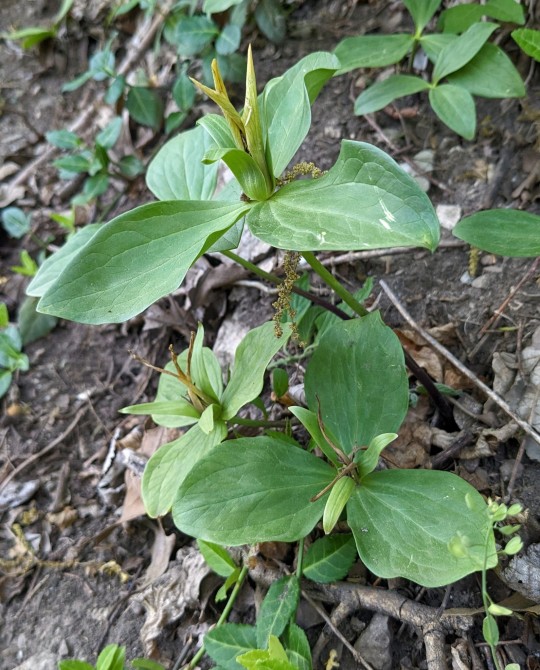
Wood Wakerobin
Trillium viride
Endemic to east-central Missouri and south-west Illinois, this trillium species can be found growing in woods with rich soils and on rocky slopes. It blooms in mid to late spring and there are lookalike trilliums; however, T. viride has a characteristic unique only to it - tiny, yet visible stomata that look like white dots all over the top of its leaves.
April 17th, 2024
St. Louis County, Missouri, USA
Olivia R. Myers
@oliviarosaline
#botany#plants#trillium#trillium viride#wakerobin#trilliums#nature#woods#forest#naturecore#missouri#Illinois#ozarks#the ozarks#goblincore#forest floor#nature photography#plant photography#flower photography#photography#green flowers#exploring the woods#the woods#woodlands#hiking missouri#fairycore#plantcore#wildflowers#spring#native plants
27 notes
·
View notes
Text

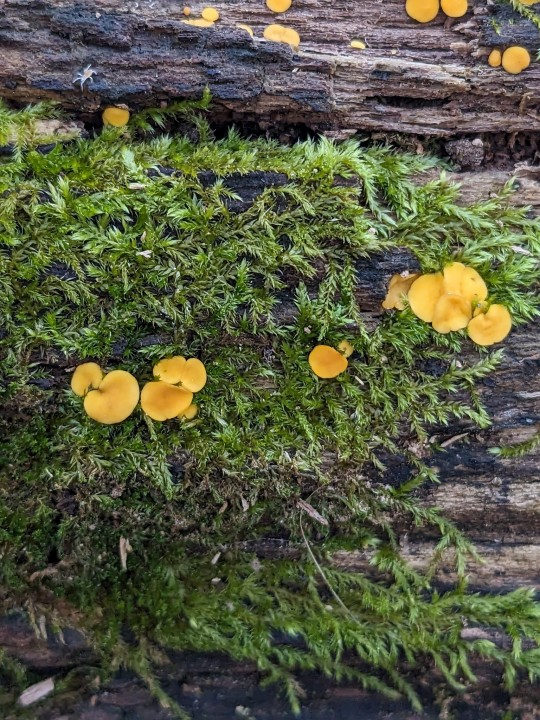
Yellow Fairy Cups
Calycina citrina syn. Bisporella citrina
November 22nd, 2023
St. Charles County, Missouri, USA
Olivia R. Myers
@oliviarosaline
#Pezizellaceae#Calycina citrina#Calycina#Bisporella citrina#Bisporella#mycology#ameteur mycology#mushrooms#fungi#fungus#wild fungi#wild mushrooms#nature#woods#naturecore#fairycore#missouri#forest#forests#forestcore#fungi photography#mushroom photography#moss#mossy#mossy forest#colorful fungi#yellow#yellow mushrooms#goblincore#cottagecore
45 notes
·
View notes
Text

Eastern Shooting Star
Primula meadia syn. Dodecatheon meadia
This native perennial has a range that spans throughout the central and eastern United States, where it can be found growing in a variety of habitats with acidic to neutral soils. Its nodding flowers resemble a shooting star and are usually white or lilac in color.
This particular plant was growing in a dolomite glade, but I've also found this species growing in moist, open forests over sandstone before.
April 18th, 2024
Jefferson County, Missouri, USA
Olivia R. Myers
@oliviarosaline
#botany#Dodecatheon meadia#Primula meadia#Primula#Dodecatheon#Primulaceae#primroses#shooting star#flowers#plants#nature#glades#Missouri#ozarks#the ozarks#plant photography#nature photography#flower photography#naturecore#fairycore#cottagecore#purple flowers#native flowers#native plants#wild flowers#wildflowers#woods#forest#photography#hiking
36 notes
·
View notes
Text

#Wolves
I need to say a few words here about Wolves and their role in biodiversity. Because I like them, but most of all, they're a must in the wilderness.
Like every time we are standing on the edge of a hiking trail of a National Park, a protected territory, we all must beware of the consequences.
Au contrary to what most people may think of its surface, no matter how large it might be, isn't big enough to sustain a healthy Wolf population over a long term. This large Predator requires a massive home range to find the prey it needs to survive. Studies have shown that all the Wolf packs in Parks must travel outside its boundaries to meet their needs. And these large Canids are also victims of habitat degradation and fragmentation, not to mention deaths of human origin.
And for people who don't know, Wolves are considered as an umbrella species. Which means that efforts to protect it benefit the entire ecosystem, since the Wolf's territory encompasses the territories of many other species with a similar home range.
As for being an apex Predators, Wolves play an important role in biodiversity. Yes, their presence has been scientifically proven to increase the abundance and diversity of plants, mamal's Birds, Amphibiants, and Reptiles. Wolves help to control the amount of Prey on their territory; this prevents an overpopulation of herbivores, which could be detrimental to plant regrowth. Wolves also give a boost to several other animal species by leaving their partially carcasses for scavengers to feed on. Through its influence on the entire food chain and by curbing excessive grazing. So yes, the Wolf is a key species needed to preserve the balance of Ecosystem.
To conclude; Wolves are very wary and will run away from any human they detect through their remarkable senses of hearing and smell - they can sniff out their Prey from more than 2kms away. Several studies have shown that Wolves will try to avoid humans at all costs and flee when approached.
Just to say that all citizens have a responsibility to protect the Wolves.
189 notes
·
View notes
Text

Fire Pink
Silene virginica
A perennial catchfly native to central and eastern North America. The bright, fiery red flowers attract ruby-throated hummingbirds to pollinate them, and sticky sepals and stems on the plant act as a trap for small insects trying to climb up it, hence the name "catchfly" for plants in this genus. It prefers somewhat dry soils and part-sun, so it can be found on rocky slopes in open woodlands, savannas, and other similar habitats.
I found this fire pink growing in open, rocky woods near blackjack oaks and other drought-tolerant species.
April 18th, 2024
St. Francois County, Missouri, USA
Olivia R. Myers
@oliviarosaline
#botany#silene#Silene virginica#catchfly#catchflies#Caryophyllaceae#plants#flower photography#plant photography#nature photography#the ozarks#Missouri#nature#wildflowers#woods#forest#naturecore#ozarks#flowers#red flowers#forestcore#naturalist#hummingbird flowers#native plants#native flowers#fairycore#spring#summer#hiking missouri#red
39 notes
·
View notes
Text


Bird's Foot Violet
Viola pedata
Named after its leaves which resemble a bird's foot... This gorgeous violet is native to a large portion of eastern North America and thrives in sandy areas, rocky slopes, and other sunny, very well-drained habitats that are undisturbed. Three different color varieties can be found in the wild; bicolor (pictured above), lilac, and white. I have found both the bicolor and solid lilac varieties in abundance within glades and some prairies here in Missouri. Additionally, this species hosts fritillary butterfly larvae and provides nectar to many other butterflies and bees.
April 18th, 2024
St. Francois County, Missouri, USA
Olivia R. Myers
@oliviarosaline
#botany#plants#nature#viola#Viola pedata#violets#bird's foot violet#naturecore#flowers#the ozarks#ozarks#Missouri#hiking Missouri#Violaceae#wild flowers#wildflowers#native flowers#native plants#prairies#prairie#glades#purple flowers#violet flowers#purple#violet#pansies#pansy#fairycore#nature photography#flower photography
26 notes
·
View notes
Text
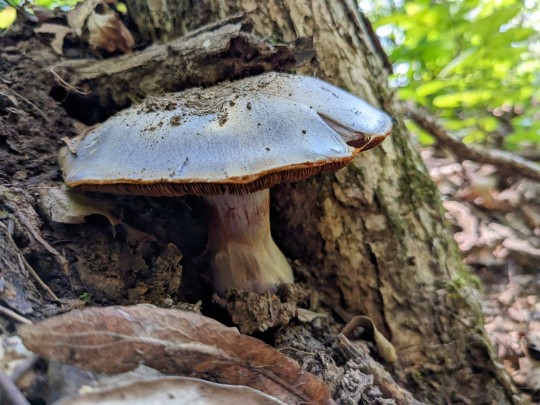
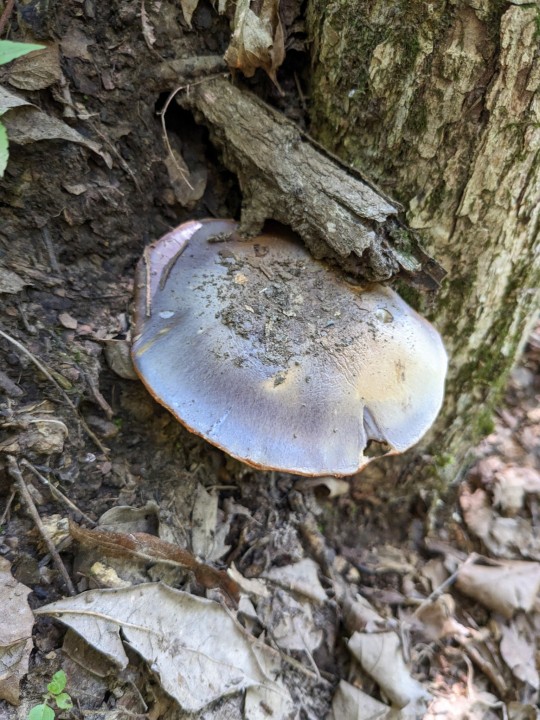
Cortinarius sp.
Commonly called "webcaps".
Young cortinarius mushrooms have a veil-like structure called a cortina between their cap and stem, which usually vanishes as they mature. Worldwide, it's estimated over two thousand species of cortinarius exist.
July 24th, 2023
Randolph County, Illinois, USA
Olivia R. Myers
@oliviarosaline
#mycology#mushrooms#mushroom#cortinarius#webcaps#webcap#cortinarius mushroom#nature#woods#naturecore#forest floor#fairycore#Illinois#forest#cottagecore#forestcore#forests#the woods#fungi#wild fungi#wild mushrooms#mushroomcore#exploring nature#mushroom photography#nature photography#fungi photography#hiking Illinois
95 notes
·
View notes
Text

Blue Vervain
Verbena hastata
With a tiny green sweat bee feeding on its flowers.
This plant was growing in a wetland along the Meramec River and is native to a large portion of North America.
July 26th, 2023
Arnold, Jefferson County, Missouri, USA
Olivia R. Myers
@oliviarosaline
#nature#naturecore#missouri#botany#bees#plants#sweat bee#green bee#green sweat bee#wetlands#verbena#vervain#Augochlora#verbena hastata#blue vervain#swamp verbena#blue flowers#purple flowers#the ozarks#fairycore#woods#bugs#pollinators#native plants#native flowers#nature photography#flower photography#plant photography#ozarks#tiny flowers
20 notes
·
View notes
Text
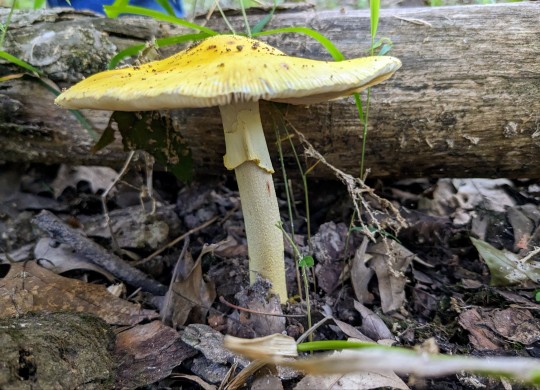


Amanita section Validae
I found this gorgeous, lemon yellow amanita mushroom in a healthy bottomland forest surrounded by pin oaks, river birches, and American elms.
July 26th, 2023
Arnold, Jefferson County, Missouri, USA
Olivia R. Myers
@oliviarosaline
#mycology#Amanita Sect. Validae#amanita mushrooms#amanita#nature#woods#naturecore#forest floor#fairycore#missouri#cottagecore#ozarks#the ozarks#forest#mushrooms#fungi#wild fungi#wild mushrooms#bottomland woods#naturalist#mushroomcore#yellow mushrooms#mushroom photography#nature photography#fungi photography#exploring the woods#mushroom#toadstool
45 notes
·
View notes
Text

Mexican Hat
Ratibida columnifera
I found this lonely blooming Mexican hat plant gleaming like a beacon light amongst a sea of non-native, invasive teasel growing in a dry, disturbed, almost waste-like land near Interstate 55 in Missouri.
This sombrero-resembling prairie coneflower is native to North America, where its historic native range primarily spanned the Great Plains and surrounding areas to the west, to Missouri on the very eastern edge of its adventive range. However, there are now naturalized populations east of Missouri. It's commonly grown in gardens and can escape from them. This species prefers dry, sunny habitats such as prairies, savannas and some disturbed areas with well-drained, neutral to alkaline soils. Its flowers provide food for an array of insect species, including bees, beetles, moths, wasps, and many more.
June 20th, 2023
Arnold, Jefferson County, Missouri, USA
Olivia R. Myers
@oliviarosaline
#Ratibida columnifera#nature#botany#plants#mexican hat#mexican hat flower#prairie coneflower#upright prairie coneflower#Ratibida#Missouri#prairie#prairies#asteraceae#naturecore#prairiecore#flowers#wildflowers#wildflower#wild flowers#native flowers#native plants#flower photography#nature photography#plant#flower#summer#summer flowers#naturalist#prairie flowers
45 notes
·
View notes
Text


Tall Thimbleweed
Anemone virginiana
This anemone is native to the United States and southern Canada, where its range extends primarily east of the Great Plains. Its common name originates from the cluster of pistils forming a thimble shape, and it can tolerate and grow in a variety of conditions. This particular plant was thriving in a partly sunny, moist area of the woods near a small creek.
June 22nd, 2023
St. Francois County, Missouri, USA
Olivia R. Myers
@oliviarosaline
#botany#anemone#Anemone virginiana#Tall Thimbleweed#thimbleweed#nature#woods#naturecore#forest#missouri#the ozarks#ozarks#naturalist#ranunculaceae#plants#flowers#wild flowers#wildflowers#native plants#native flowers#nature photography#flower photography#plant photography#hiking missouri#plants of the ozarks#exploring the woods#the woods#forests#forestcore
37 notes
·
View notes
Note
your photos are beautiful! (and i love love love that you include species info)
Thank you! I love sharing information on my posts so others may learn with me... even if it's one small, interesting piece of info at a time. I really appreciate the compliment about my photos, too. :)
7 notes
·
View notes
Text



Mica Cap Mushrooms
Coprinellus sect. Micacei
Growing at the base of an old cottonwood tree in the woods.
April 3rd, 2024
St. Louis County, Missouri, USA
Olivia R. Myers
@oliviarosaline
#mycology#nature#woods#naturecore#forest#forest floor#missouri#ozarks#the ozarks#mushrooms#mushroom#wild fungi#fungi#Coprinellus#Psathyrellaceae#mica cap#mica capa#fairycore#cottagecore#the woods#exploring the woods#Missouri nature#ink caps#inky caps#wild mushrooms#nature walk#hiking missouri#mica cap mushrooms#Coprinellus micaceus#forestcore
34 notes
·
View notes
Text

Ink Cap Mushroom
Psathyrellaceae
April 3rd, 2024
Saint Louis County, Missouri, USA
Olivia R. Myers
@oliviarosaline
#nature#naturecore#forest floor#fairycore#missouri#ozarks#the ozarks#mycology#mushrooms#mushroom#fungi#wild fungi#ink cap mushroom#inkcap#inky cap#ink cap#Psathyrellaceae#cottagecore#woods#forest#spring#inkcaps#wild mushrooms#Missouri nature
35 notes
·
View notes
Text


Prairie Trillium
Trillium recurvatum
These unique, dark trillium plants caught our eye while we were exploring woods in Jersey County, Illinois. This species usually has splotchy green leaves. dailybotany suggested these trillium plants may have upped their anthocyanin production in response to exposure to higher levels of solar radiation. There were a few of these trilliums with dark leaves in the general area, and it may have been a sunnier than usual spot in the understory of the forest there, so this theory makes sense. I still wonder if it's possible this small population carries a genetic mutation... I have explored many woods and never seen trilliums this dark. I love listening to different theories and learning new info.
Trillium recurvatum is native to much of the Mississippi River basin in the central / eastern United States. Eastern Ohio has a few populations, which are listed as potentially threatened by their DNR. There are also a couple isolated populations in North Carolina, but it's debated whether or not they were actually planted long ago. Its closest lookalike with overlapping range is trillium sessile; however, the sepals on s. recurvatum plants curve downward as the flower opens, and the stem is usually much shorter than on t. sessile. This species can grow in habitats ranging from floodplains, to mesic forests and mesic savannas. Often, they're found growing in calcareous soils or over calcium-rich rocks such as limestone.
March 20th, 2024
Jersey County, Illinois, USA
Olivia R. Myers
@oliviarosaline
#botany#trillium recurvatum#trillum#trilliums#wakerobin#wake robin#black plants#nature#woods#naturecore#forest floor#forest#forests#Illinois#nature photography#plant photography#nature walk#melanthiaceae#liliales#black#unique plants#forestcore#hiking Illinois
38 notes
·
View notes
Text
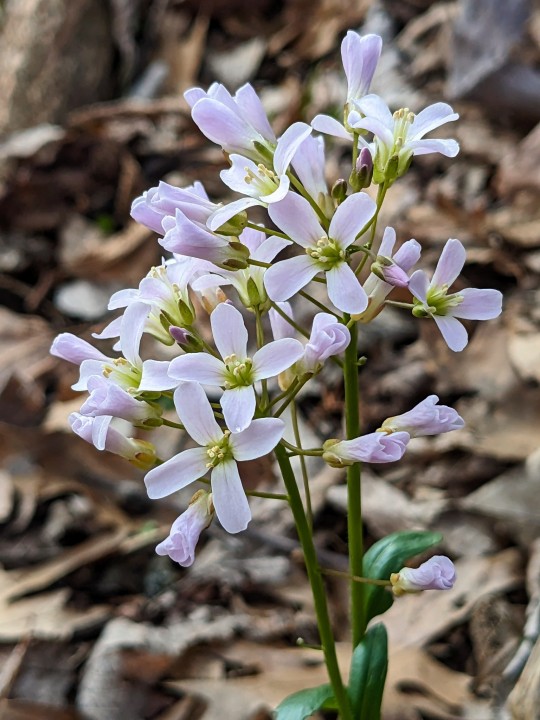

Purple Cress
Cardamine douglassii
Also known as Limestone Cress, this species in the mustard family features clusters of light purple flowers in early spring and can be found in wet and swampy forests with calcium carbonate rich soils. It's native to parts of the eastern United States and southern Ontario, Canada.
The plants I photographed are part of an isolated population remaining in a tiny bottomland forest remnant in St. Charles County, Missouri. Unfortunately, the rest of the forest has been lost due to suburban sprawl and what little of it remains has many invasive species, including winter creeper, callery pear, and japanese honeysuckle trying to encroach from surrounding developments and outcompete native plants like this one.
March 12th & 13th, 2024
St. Charles County, Missouri, USA
Olivia R. Myers
@oliviarosaline
#botany#cardamine douglassii#cardamine#purple cress#bittercress#brassicaceae#nature#naturecore#forest#fairycore#woods#missouri#native plants#native flowers#forests#hiking missouri#suburban sprawl#urban sprawl#ecology#plants#flowers#wildflowers#purple flowers#native plants of america#forest floor#bottomland woods#bottomland forests#nature photography#flower photography#spring
36 notes
·
View notes
Text
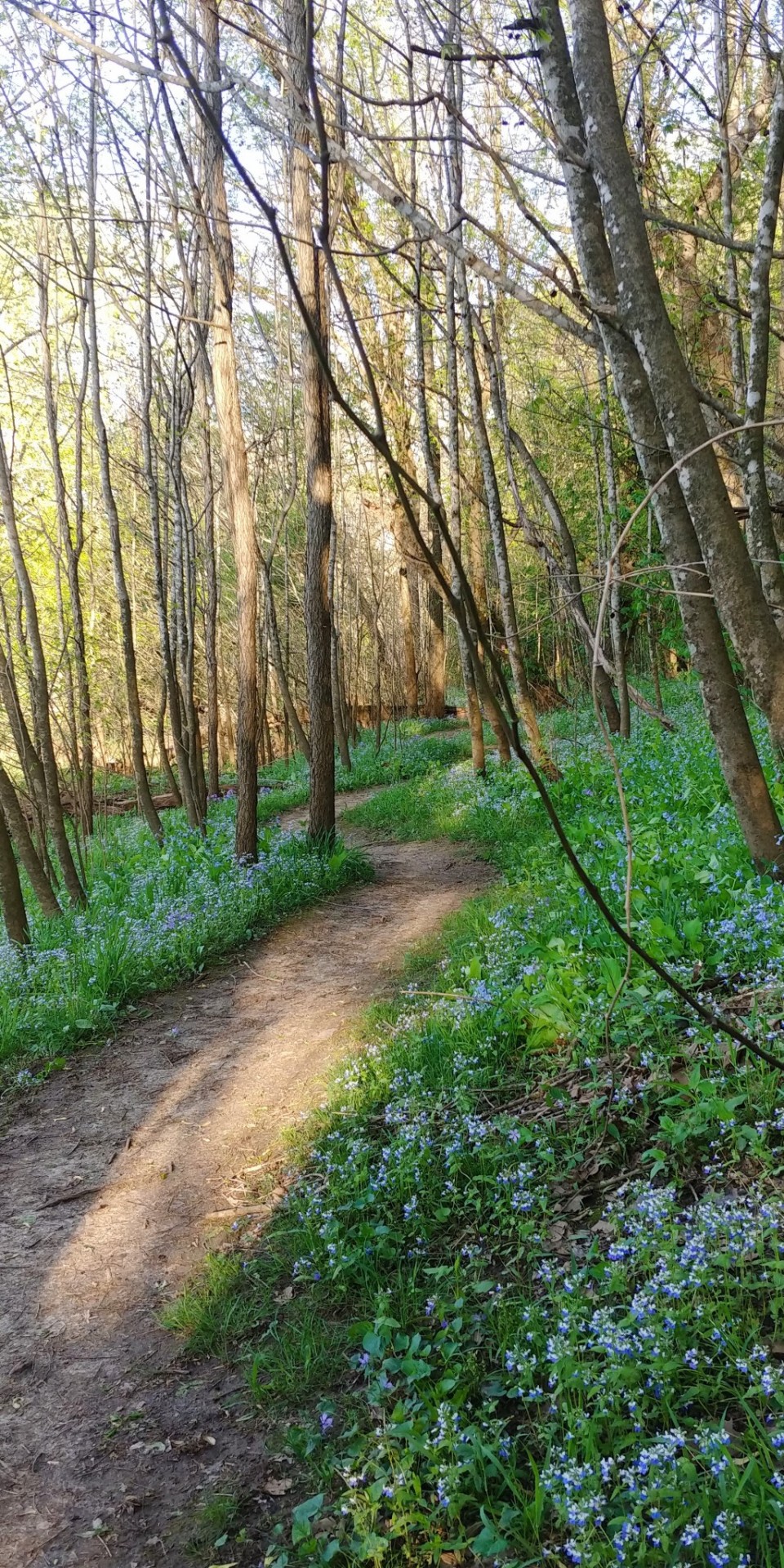


Wildflowers flourishing along a tranquil Ozarkian trail. It was a blessing to enjoy this beautiful place where the sun kissed spots of the blue forest floor and only the sound of bird songs and soft wind whispered through the trees. The blue-eyed mary (Collinsia verna) and virginia bluebells (Mertensia virginica) thriving on the forest floor are both native spring ephemerals found throughout the central and eastern parts of North America.
April 17th, 2023
Washington County, Missouri, USA
Olivia R. Myers
@oliviarosaline
#nature#woods#naturecore#fairycore#cottagecore#missouri#ozarks#the ozarks#forest#flowers#forest floor#wildflowers#spring#spring flowers#Virginia bluebells#blue-eyed mary#Mertensia virginica#collinsia verna#collinsia#mertensia#landscape#landscape photography#flower photography#nature photography#forest photography#hiking missouri#trail#hiking
115 notes
·
View notes